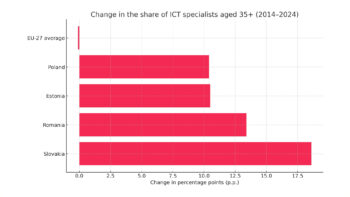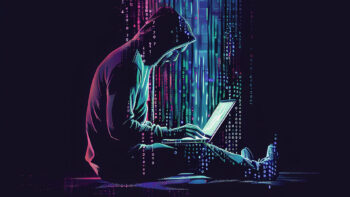Recent years have seen a sharp rise in cyber threats, with ransomware being one of the most acute. Dariusz Szwed – an expert at Canon Polska who deals with office digitisation and cyber security issues – points out that the problem no longer affects only global corporations, but also small and medium-sized enterprises, which often do not have adequate resources to effectively counter cyber attacks.
“There is no longer a lower limit to the size of companies where ransomware can be applied. Sometimes we find that it is easier for hackers to take control of a smaller company, lock it down and demand payment, than to risk an attack on a large player with much more resources.”
Dariusz Szwed, Canon Polska
In the context of data protection, the role of modern technologies such as cloud computing is increasingly being pointed to. This solution not only enables faster recovery after an attack, but also improves security thanks to built-in security mechanisms. However, there is still a lack of full trust in the cloud in Poland, which, as Szwed points out, generates the need to raise awareness in this area.
The cloud as the key to security
One of the key strengths of the cloud is the ability to quickly recover from an attack, which significantly minimises downtime for a company. Dariusz Szwed points out that with cloud solutions, companies can not only quickly restore data after an attack, but also gain confidence that it is constantly monitored and protected by the best available technology.
However, there is still a noticeable caution in the adoption of cloud technologies in Poland, which is mainly due to concerns about security and trust in providers.
“Polish organisations, both in the private and public sector, are far less trusting of the cloud environment than is the case in other European countries. In our country, the largest institutions are still tied to on-premise solutions, which involves building additional server rooms and managing them with their own resources.”
Dariusz Szwed, Canon Polska
Meanwhile, global data clearly shows that organisations using cloud solutions are better prepared for cyber attacks than those relying solely on traditional IT infrastructure. Another important aspect is the scalability and flexibility of the cloud. It allows companies to adapt IT resources to changing needs, which is particularly important in the context of remote working and distributed teams.
Cyber security education
Cyber security education is becoming one of the most important elements of an effective data protection strategy. Dariusz Szwed points out that the biggest threat to companies is not the technologies themselves, but the lack of proper knowledge and awareness among employees. It is human error, stemming from ignorance or unawareness, that is the most common reason for the success of social engineering attacks such as phishing. Modern attacks are increasingly based on manipulation of the human psyche rather than technical vulnerabilities in systems. Education in this area should not be limited to basic training, but should also include regular reminders and simulations that help consolidate correct habits and responses to threats. Swede notes that traditional training that takes place once in a while is no longer sufficient. Cyber security should be integrated into the daily operation of the company and be an integral part of the organisational culture. This is an approach that, in the long term, minimises the risks associated with attacks. Education should apply not only to employees, but also to management, whose responsibility for data security is particularly relevant in the context of legislation such as the NIS 2 directive.
NIS Directive 2: New challenges and responsibilities
The NIS 2 Directive, which came into force in 2023, is a significant step towards increasing the level of cyber security in the European Union. It introduces new security requirements across a range of sectors, including critical infrastructure, information and communication technology and digital services. One of the key aspects of this directive is the adoption of the principle of accountability at all levels of an organisation, meaning that managers and business owners must be personally involved in digital security issues. The Canon Poland expert emphasises that the NIS 2 directive has a significant impact on the way cyber security is managed in companies, especially in terms of the responsibility of those in managerial positions. It changes the approach to risk management, as the directive explicitly places the responsibility on managers to respond to threats and monitor the company’s cyber security situation. Dariusz Szwed also notes that while the NIS 2 directive imposes obligations on companies, it is also a good opportunity to start considering cyber security as an integral part of a growth strategy.
Remote working and digital security
The COVID-19 pandemic has significantly accelerated the transition to remote working, which has introduced new digital security challenges. Many companies were forced to rapidly adapt their structures to the new mode of working, and this meant implementing new technology solutions and data protection procedures. In response to these changes, cyber threats related to remote working have become an important topic in the area of risk management. Dariusz Szwed notes that while remote working is not a threat in itself, its implementation without proper protection procedures can lead to serious security vulnerabilities. However, remote access to company resources, without adequate protection measures, creates an opportunity for cybercriminals who can exploit these vulnerabilities to launch attacks, such as phishing attacks, on poorly secured devices and user accounts. To counter the risks associated with remote working, Swede emphasises the importance of investing in security technologies.
Ecology and sustainability in printing technologies
Dariusz Szwed points out that ecology is becoming an important factor in technology selection, also in the context of office equipment. The expert notes that companies are increasingly paying attention to environmental issues when choosing technology, including printing devices. Sustainability is becoming one of the criteria that influence purchasing decisions. In this context, particular attention is being paid to energy efficiency, consumption of consumables, as well as the life cycle length of equipment, thus reducing waste and environmental impact. With increasing environmental awareness, many print device manufacturers, including Canon, are betting on sustainability and eco-friendly innovations.
“An environmental approach is a very important part of Canon’s strategy. As a Japanese organisation, we operate with the mindset of Kyosei, which means we work, we build business for the common good. Canon has for years taken measures to minimise the environmental impact of its production. This includes not only taking care with consumables, but also designing devices to have the longest possible life cycle and minimising energy consumption.”
Dariusz Szwed of Canon Polska.
These measures include, among other things, the production of energy-efficient equipment, as well as the implementation of recycling programmes that allow the reuse of spare parts and consumables. It is also worth noting that sustainability in the context of printing does not end with the production of devices and consumables alone. Canon is already implementing solutions to optimise office printing processes, resulting in lower paper, ink and energy consumption. Such solutions allow companies to continuously monitor their operations and make improvements that are both environmentally and economically beneficial.
Confidence and innovation in printing equipment technology
Confidence in printing equipment technology underpins companies’ purchasing decisions. Today’s printing market places increasingly demanding expectations on equipment manufacturers, both in terms of performance and security. Customers are guided not only by price, but also by the quality, reliability and innovation of the solutions offered when deciding on a particular piece of equipment. Trust in equipment is directly linked to its durability, energy efficiency, as well as the ever-increasing requirements for data protection and digital security. Dariusz Szwed notes that trust in printing equipment is crucial to the decision-making process in companies.
“Trust in printing equipment is essential because if it fails or has print quality issues, a company can suffer serious losses. Companies expect not only functionality, but also longevity of equipment that will be reliable for many years.”
Dariusz Szwed of Canon Polska.
For this reason, it becomes crucial to design equipment with durability and stability of operation in mind, which affects the long-term satisfaction of users. Innovations in printing technology also play an important role in improving the quality of equipment and increasing confidence in devices.











